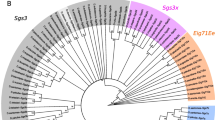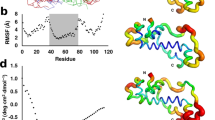Summary
We have studied the evolutionary changes occurring in the noncoding regions around the developmentally important fushi tarazu (ftz) gene in a total of 11 species in the genus Drosophila. Previous molecular developmental studies have identified DNA elements both 3′ and 5′ to the coding region which are important in proper regulation of expression of the Drosophila melanogaster ftz gene. We show here that these same elements are the most evolutionarily conserved regions in the vicinity of the gene homologs. Parts of some control elements are more conserved than exonic sequences. Not only is there sequence conservation, but the relative position, orientation, and distances among the control elements remain conserved. One quite significant difference does exist between the two major subgenera studied, Sophophora and Drosophila: namely, an inversion of the ftz unit with respect to other genes in the Antennapedia complex, ANT-C. As a comparison, we applied similar analysis to a “housekeeping” gene-rosy (ry), or Xdh. In contrast, DNA sequences 5′ to the ry coding region revealed little evolutionary conservation. These studies bear out the proposition that functionally important DNA sequences remain more conserved through evolutionary time than do less functionally important sequences. This proposition could be tested in the present case because we could predict a priori from the developmental studies which DNA regions should be most conserved.
Similar content being viewed by others
References
Amati B, Pick L, Laroche T, Gasser SM (1990) Nuclear scaffold attachment stimulates, but is not essential for ARS activity in Saccharomyces cerevisiae: analysis of the Drosophila ftz SAR. EMBO J 9:4007–4016
Beverly SM, Wilson AC (1984) Molecular evolution in Drosophila and higher Diptera. II. A time scale for fly evolution. J Mol Evol 21:1–13
Bienz-Tadmore B, Zakut-Houri R, Libresco S, Givol D, Oren M (1985) The 5′ region of the p53 gene: evolutionary conservation and evidence for a negative regulatory element. EMBO J 4:3209–3213
Caccone A, Powell JR (1990) Extreme rates and heterogeneity in insect DNA evolution. J Mol Evol 30:273–280
Caccone A, Gleason JM, Powell JR (1992) Complementary DNA-DNA hybridization in Drosophila. J Mol Evol 34:130–140
Coté B, Bender W, Curtis D, Chovnick A (1986) Molecular mapping of the rosy locus in Drosophila melanogaster. Genetics 112:769–783
DeSalle R (1992) The phylogenetic relationship of flies in the genus Drosophila. Mol Phyl Evol 1:31–40
Feinberg AP, Vogelstein B (1983) A technique for radiolabelling DNA restriction endonuclease fragments to high specific activity. Anal Biochem 132:6–13
Garber RL, Kuroiwa A, Gehring WJ (1983) Genomic and cDNA clones of the homeotic locus Antennapedia in Drosophila. EMBO J 2:2027–2036
Gasser SM, Laemmli UK (1986) Cohabitation of scaffold binding regions with upstream/enhancer elements of three developmentally regulated genes of Drosophila melanogaster. Cell 46:521–530
Hilliker AJ, Clark SH, Chovnick A, Gelbart WM (1980) Cytological analysis of the chromosomal region immediately adjacent to the rosy locus in D. melanogaster. Genetics 95:95–110
Hiromi Y, Kuroiwa A, Gehring WJ (1985) Control elements of the Drosophila segmentation gene fushi tarazu. Cell 43:603–613
Ingham P (1988) The molecular genetics of embryonic pattern formation in Drosophila. Nature 335:25–34
Jürgens G, Wieschaus E, Nüsslein-Volhard C, Kluding H (1984) Mutations affecting the pattern of the larval cuticle in Drosophila melanogaster. II. Zygotic loci on the third chromosome. Roux's Arch Dev Biol 193:283–295
Jukes TH, King JL (1979) Evolutionary nucleotide replacement in DNA. Nature 281:605–606
Keith TP, Riley MA, Kreitman M, Lewontin RC, Curtis D, Chambers G (1987) Sequence of the structural gene for xanthine dehydrogenase (rosy) in Drosophila melanogaster. Genetics 116:67–73
Kuroiwa A, Hafen E, Gehring WJ (1984) Cloning and transcriptional analysis of the segmentation gene fushi tarazu of Drosophila. Cell 37:825–831
Lee CS, Curtis D, McCarron M, Love C, Gray M, Bender W, Chovnick A (1987) Mutations affecting expression of the rosy locus in D. melanogaster. Genetics 116:55–66
Li W-H, Lui C-C, Wu C-I (1985) Evolution of DNA sequences. In: MacIntyre RJ (ed) Molecular evolutionary genetics. Plenum Press, New York, pp 1–94
Maier D, Preiss A, Powell JR (1990) Regulation of the segmentation gene fushi tarazu has been functionally conserved in Drosophila. EMBO J 9:3957–3966
Maniatis T, Hardison RC, Lacy E, Lauer J, O'Conell C, Quon D, Sim GK, Efstradiatis A (1978) The isolation of structural genes from libraries of eucaryotic DNA. Cell 15:687–701
Maniatis T, Fritsch EF, Sambrook J (1982) Molecular cloning: A laboratory manual. Cold Spring Harbor Laboratory, Cold Spring Harbor, New York
Nüsslein-Volhard C, Wieschaus E (1980) Mutations affecting segment number and polarity in Drosophila. Nature 287:795–801
Pattatucci AM, Otteson DC, Kaufman TC (1991) A functional and structural analysis of the Sex combs reduced locus of Drosophila melanogaster. Genetics 129:423–441
Pick L, Schier A, Affolter M, Schmidt-Glenewinkel T, Gehring WJ (1990) Analysis of the ftz upstream element: germ layer-specific enhancers are independently autoregulated. Genes Dev 4:1224–1239
Preiss A, Hartley DA, Artavanis-Tsakonas S (1988) The molecular genetics of Enhancer of split, a gene required for embryonic neural development in Drosophila. EMBO J 7:3917–3927
Pustell J, Kafatos FC (1984) A convenient and adaptive package of computer programs for DNA and protein sequence management, analyses, and homology determination. Nucl Acids Res 12:643–655
Rigby PWJ, Dieckmann M, Rhodes C, Berg P (1977) Labelling desoxynucleic acid to high specific activity in vitro by nick translation with polymerase I. J Mol Biol 113:237–251
Riley MA (1989) Nucleotide sequence of the Xdh region in Drosophila pseudoobscura and an analysis of the evolution of synonymous codons. Mol Biol Evol 6:33–52
Rubin GM, Spradling AC (1983) Vectors for P-element mediated gene transfer in Drosophila. Nucl Acids Res 11:6341–6351
Sanger F, Nicklen S, Coulson AR (1977) DNA sequencing with chain-terminating inhibitors. Proc Natl Acad Sci USA 74: 5463–5467
Schaeffer SW, Aquadro CF (1987) Nucleotide sequence of the alcohol dehydrogenase region of Drosophila pseudoobscura evolutionary change and evidence for an ancient duplication. Genetics 117:61–73
Scott MP, Weiner AJ, Hazelrigg TI, Polisky BA, Pirotta V, Scalenghe F, Kaufman TC (1983) The molecular organization of the Antennapedia locus of Drosophila. Cell 35:763–776
Scott MP, Carroll SB (1987) The segmentation and homeotic gene network in early Drosophila development. Cell 51:689–698
Tabor S, Richardson CC (1987) DNA sequence analysis with a modified bacteriophage T7 DNA polymerase. Proc Natl Acad Sci USA 84:4767–4771
Throckmorton LH (1975) The phylogeny, ecology and geography of Drosophila. In: King RC (ed) Handbook of genetics, vol 3. Plenum Press, New York. pp 421–469
Wakimoto BT, Kaufman TC (1981) Analysis of larval segmentation in lethal genotypes associated with the Antennapedia gene complex in Drosophila melanogaster. Dev Biol 81:51–64
Wheeler MR (1981) The Drosophilidae: A taxonomic overview. In: Ashburner M, Carson HL, Thompson JN (eds) The Genetics and Biology of Drosophila Vol 3a. Academic Press, London and New York, pp 1–97
Author information
Authors and Affiliations
Rights and permissions
About this article
Cite this article
Maier, D., Sperlich, D. & Powell, J.R. Conservation and change of the developmentally crucial fushi tarazu gene in Drosophila . J Mol Evol 36, 315–326 (1993). https://doi.org/10.1007/BF00182179
Received:
Accepted:
Issue Date:
DOI: https://doi.org/10.1007/BF00182179




